
|
|
- Swooping from City to City – Team South Africa
- Peter Lawson Cup 2018
- "Winging' It" at the 2nd FAI Wold Wingsuit Champs
- How can I compete at the CP World Cup next year?
- Aero Club membership
- Licences and Ratings
|
|
|
What an incredible way to showcase the sport we all love so dearly… SWOOP FREESTYLE FAI WORLD CHAMPIONSHIPS 2018 was, without a shadow of doubt, an impressive advert for the sport. Unlike all the other major skydiving competitions on the international calendar, SWOOP FREESTYLE FAI WORLD CHAMPIONSHIPS is an invitational event for 18 of the world’s finest pilots from across the globe. Both Chris Teague and Billy Sharman of Skydive Pretoria were invited and hosted at this year’s double venue freestyle series. Both Copenhagen (Denmark) and San Diego (California, USA) turned on the charm, boasting amazing skylines, lakes and marinas for the competitors to express themselves. Every pilot was there to put on a show, competing for top honours for the title of World Freestyle Champion.
The athletes were required, over a series of 6 jumps (2 training, 2 qualifying and 2 finals), to perform 2 freestyle moves per swoop over a body of water. That may sound simple, however, the competitors were then required to finish their moves on a 6m by 25m floating raft in front of the crowds – FANTASTIC.
|
|
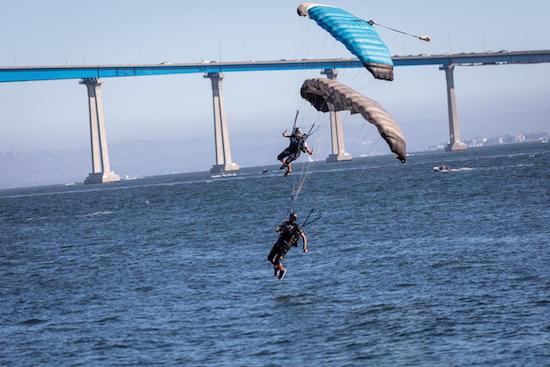 Chris about to land and Billy filming. Photo: Logan Donavon Chris about to land and Billy filming. Photo: Logan Donavon
|
|
South Africa can be proud as Chris Teague was representing the country as a competitor and Billy Sharman as an air-to-air cameraman. Billy’s exceptional work was viewed all over the world both live and post-production. A world first live production, across two cities on two continents, with live scoring, was enjoyed by thousands of people from all corners of the earth.
As Chris Teague’s 1st SWOOP FREESTYLE FAI WORLD CHAMPIONSHIPS, the results were strong. In Copenhagen Chris placed 7th, landing on the raft in both the final rounds. San Diego proved a little more challenging with exciting open water conditions. Chris finished 14th in San Diego bringing his overall championship position to a tied 11th. Chris has already commenced with his training for the 2019 series.
|
|
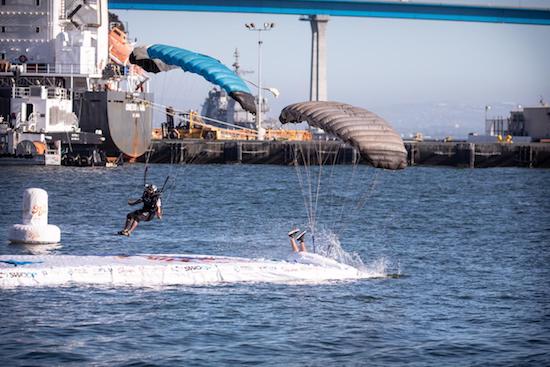 Photo: Logan Donavon Photo: Logan Donavon
|
| A combination of 18 cherry picked athletes, 2 international built up city venues, open-door helicopters, wingsuit base jump demos, night free fly displays, pyrotechnic night swooping shows, huge flag jumps, powered and aerobatic paragliding made the SWOOP FREESTYLE FAI WORLD CHAMPIONSHIPS 2018 an incredible show and a highly successful and competitive competition for all involved. |
|
|
|
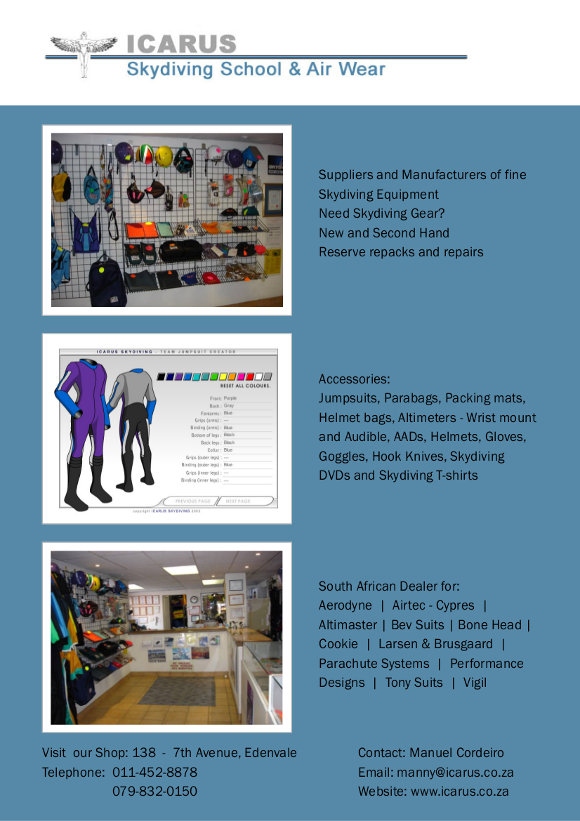
|
|
|
|
This year's Peter Lawson Cup was a great success: 46 competitors, 5 disciplines, 42 loads flown in 3 days, although we had some wind. All competitors that came first on the podium won cash prizes and share R20,000 that was sponsored by Aerodyne, James Meyer, Harri Viljoen and Skydive Pretoria. Many other prizes were handed out to all those on the podium, first time competitors and raffled away.
One discipline sure stood out - Vertical Formation Skydiving!
Skydive Pretoria hosted the Peter Lawson Cup again this year and the AE SSA committee decided to get in on the fun and support the teams.
Skydive Pretoria came up with a great initiative to pair up junior and senior AE jumpers to all compete on equal footing in the 2 way Vertical Formation Skydiving category. This was received well by both seniors and juniors and a total of 5 teams ended up battling it out.
|
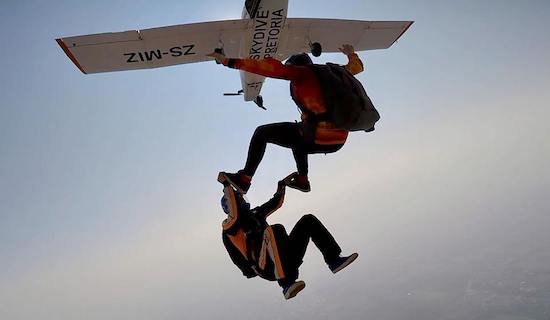 Schrödinger's Cat (Quinton Henning and Lé-Ann Prinsloo) Photo credit: Julie Teague Schrödinger's Cat (Quinton Henning and Lé-Ann Prinsloo) Photo credit: Julie Teague
|
| As most teams had never competed or jumped together before, Saturday was reserved as a training day and on Saturday evening the draw for the jumps were revealed. Each team had to do 3 Head Up rounds, which made it accessible to all the juniors competing. |
|

VFS podium. Photo credit: Peter Lawson.
|
|
After battling it out on Sunday and Monday, Team Carlton-Boom (Christopher Teague and Travis Grosch) took the Gold, with Team Shrödinger's Cat (Quinton Henning and Lé-Ann Prinsloo) taking second place and Team Any Funking Name Wouldn't Do (Travis Baikie and Renier Jansen) taking third place.
We couldn't be more impressed by all the competitors and the skills they demonstrated. At the same time everyone kept it light and took advantage of this learning opportunity.
We are hopeful that this fuelled some fires for Nationals 2019 and for AE in South Africa.
Full results can be found on InTime Scoring.
Maryke Prinsloo, C1854
|
|
|
|
|
| During the week of 26 August – 2 September 2018, I represented South Africa at the 2nd FAI World Wingsuit Flying Championships, held in Prostějov, Czech Republic. Wingsuit flying is a very new competition discipline, having only been recognized as such by the FAI during 2015, and consists of two sub-disciplines, namely: Acrobatic Wingsuit Flying (2 way with a camera person, fairly similar to the rules of AE/”Freeflying”) and Wingsuit Performance Flying (which is what I compete in and what this article will focus on.) In total, 23 Nations were represented, with 63 performance competitors and 5 acrobatic teams competing. |
| A wingsuit performance flying competition is made up of three rounds, each consisting of three tasks (jumps), namely: speed, distance and time. In each of these tasks, a competitor’s performance is measured by using a Flysight GPS unit, mounted on their helmet, to track the average (ground) speed, straight-line distance or time spent in the competition window (3000m – 2000m AGL). Ideally, jumps are made from around 4000m (13000ft), so that competitors can dive to build up enough vertical speed before entering the competition window. Depending on the task, this vertical speed is then converted into maximum lift (for the time task), maximum glide (for the distance task) or retained (for the speed task.) |

68 competitors represented 23 Countries
(Photo: Hendri Liebenberg) |
|
The top competitor in each task is awarded 100%, with the other competitors being awarded a percentage, based on their performance relative to the top competitor’s. Accumulated scores of the three rounds are averaged out, to give each competitor a score out of 300.
I arrived in Prostějov on the Thursday before the competition started in order to get some last minute training jumps in and familiarise myself with the DZ’s landmarks. I was very happy to finally meet Alexey Galda (USA) there, as he had been coaching me online for the past few months. Being the only South African there, I was fortunate to be immediately befriended by the German, Italian, Swedish and Australian teams and their friendship and helpful advice, as well as transport to/from the DZ was very welcome, indeed! In my opinion, the true value of attending a world-level event, such as this, lies in the friendships made! No amount of social media activity can ever substitute the real-world interaction that takes place (over a beer, or two, of course!) after a day’s jumping.
Monday marked the start of the competition, with two official training jumps that were scored by the judges to test the system. What a disaster! During the first training jump, 100% of competitors were given a 50% penalty and during the second training jump, 90%+ of competitors were given a 100% penalty. The chief judge promptly called a technical meeting and explained that he had petitioned the jury to waive competition rule 3.5.4 (deviation from designated flight path), as it would be a farce to have a World Championships with nothing but zeros on the scoreboard. Rule 3.5.3 (of which there were no less than a 126 violations during the course of the competition, would remain in force, but more on this later…)
During the Monday’s first official training jump, I had the (previously unexperienced ;-)) pleasure of test jumping my Smart LPV reserve, after my main canopy tried its best to kill me. This, together with a really violent, out of control wingsuit flatspin during the pre-event training, have made me realise, without a shadow of doubt, the absolute necessity of making the change to a 7-cell, wingsuit-specific main canopy if one is going to be flying high performance wingsuits! Also, SKYHOOK ROCKS!!! (You had to be there to fully appreciate how quickly and line-twist free my reserve opened after the spinning mal from hell…)
|
|

Getting the latest gear is prohibitively (read:
extremely!) expensive when you’re paying in
Rands, but thanks to Aerodyne, Squirrel and
Cookie’s support, I was kitted out with the
best! (Photo: DZ Prostějov staff)
|
Still shell-shocked from the two incidents described above, I flew the first round quite conservatively, but still got decent-enough scores of 241 km/hr, 82.2 seconds (my personal best) and 3717m. Then the lane violation penalty monster (rule 3.5.3, as mentioned above) kicked in, taking 10% off my speed score, 50% off my time score and a whopping 100% off my distance score. Sadly, this put me in last place and ended any chance of me getting a decent placing. At first, I was perplexed at this and couldn’t figure out how these violations could’ve happened, as I had memorised the given flight paths and sacrificed performance in order to focus on navigation.
|
|
After many discussions with fellow competitors and some really superb explanations and advice from Marco Pistolesi (ITA), I finally figured out that the lane violations were a result of the forward throw of the aircraft as well as the crosswind drift making me infringe on the right side of the lane.
This ended up to be the overriding cause of lane violation penalties for most competitors and the general consensus is that marking the centre point of the lane 5 seconds after exit doesn’t allow nearly enough time to complete the turn and counter the effects of the aircraft’s forward throw. Why the powers that be chose to test this new rule at a world championship event was a source of great frustration amongst almost all of the competitors and it left a bad taste. At the competitors meeting after the competition, everyone was in agreement that the implementation of this rule wasn’t properly thought through and it needs to be replaced with another that gives competitors the chance to fly their best performance, without being penalized so harshly. The two main ideas for a replacement rule was to change this time to 10sec after exit, or to fix it at the window entry at 3000m AGL. Either way, there will be some lively debates at the IPC Plenary 2019, I’m sure…
From the second round, I changed my strategy completely, aiming to overcorrect my turn (120° to the left) as soon as I exited the aircraft and then continue to aim to the left of my designated final reference point and voila, no more penalties after the first task of the second round! Even though it was impossible to make a decent comeback from the 50% and 100% penalties in the first round, I managed to consistently fly better until the final jump, ending up in 55th place and setting two new FAI African records in the Speed (260.3 km/hr) and Distance (3898m) tasks, both of which were previously held by Waldo Prinsloo.
|

GoPro Fusion 360° shot of the all the wingsuit competitors (Photo: DZ Prostějov staff)
I am honoured to have had this opportunity to compete against, and learn from, the world’s best and I am committed to representing South Africa again at the World Cup in 2019 and the World Championships in 2020. Wingsuit Performance flying is the perfect competition discipline for me, as it is a solo event, doing away with the complexities of dealing with a team structure, and one is essentially competing against oneself, continuously trying to better understand the dynamics of flight and improve one’s personal bests. Online competitions have been around for a while now, but since the beginning of 2018, the ability to compete with winds cancelled (so everyone can compete on an even playing field), has popularized this discipline even more (see: https://wingsuit.world/). Throughout the remainder of this year I’ll be presenting some seminars on wingsuit performance flying techniques and strategies and the plan is to organise regular mini-performance (1 round / 3 tasks) competitions, starting at this year’s tonto boogie (23 - 25 November 2018).
I would be amiss not to thank Aerodyne, Squirrel and Cookie composites for their generous gear support, as well as Johannesburg Skydiving Club (and pilot Johno!) for always generously accommodating my exit altitude and 4-5 NM spot requirements when I’m training and competing online!
If you’re interested in getting involved in this rapidly-evolving discipline or would just like some more info on wingsuit flying in general, feel free to contact me on info@humanflight.ws
Blue skies!
Hendri Liebenberg
D938
 Wingsuit competitors in front of DZ Prostějov’s Let L-410 Turbolet jumpship Wingsuit competitors in front of DZ Prostějov’s Let L-410 Turbolet jumpship
(Photo: DZ Prostějov staff)
|
|
|
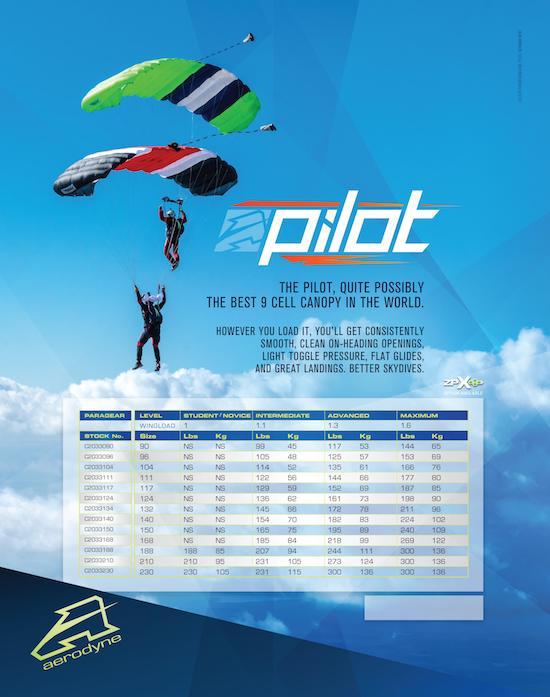
For further information please contact:
ned.luker@gmail.com / ned@flyaerodyne.com
031 502 6435
|
|
|
|
Skydive Pretoria is hosting a World Cup in Canopy Piloting in November 2019. Every athlete we have spoken to is extremely excited about coming back to South Africa, after the widely successful 2008 World Champs.
Now the question is, what does it take for South African’s to compete in this incredible event, happening right here on our doorstep?
Step 1: Qualify to compete in the Open Class CP National Championships in 2019. Our MOPs is very clear in terms of the requirements, section 10 stipulates the following requirements to qualify as an Open Class Pilot:
• Have taken part in the Intermediate / Open category at a previous PASA National Championships or SSA sanctioned competition.
• Have done a minimum of 1000 jumps.
• Cleared by a CP Coach for Open Class.
• Completed a 50m course 3 times with 5ft gates over water. Attempts must be pre-declared. A missed attempt will restart the count.
• Weight restrictions as per FAI.
• Competition rules as per FAI.
Step 2: Meet the performance criteria at the CP National Championships, these criteria are documented in the “PASA SSA Nationals Regulations Team Selection and Colours Criteria” document, the longest document name in history. :D
The criteria are as follows:
The selection will then be made on the following ranking order:
• 1st Distance,
• 1st Speed,
• 1st Zone Accuracy,
• 1st Overall,
• 2nd Distance,
• 2nd Speed,
• 2nd Zone Accuracy,
• 2nd Overall.
Competitors who place between 3rd place and 6th place for a World Championships, or 10th place for a World Cup, will have additional qualification criteria to be selected. These competitors must obtain a minimum of 50% of the score of the winner at the South African National Championship.
Up to 2 “wild card” competitors may be selected by the CP committee. This selection will be based on their performance at Nationals and other competitions during that year. The overall score of these 2 competitors must be at least 50% of that achieved by the overall winner at the National Championship.
So there you have it, get training, don’t suck and come compete and represent your country at one of the most entertaining skydiving events in the world.
Matteo Pagani, D943
|
|
|
|
|
All PASA members note:
If you receive an email from the Aero Club like the one below, please ignore it. The Aero Club system is geared to their own financial year-end which is 31 December.
PASA's year-end is 31 March so all PASA memberships remain valid until 31 March annually.
PASA has an agreement with the Aero Club that all PASA members are considered paid-up to 31 March of the following year.
|
The following new memberships have been activated on your account:
The Aero Club of South Africa (AeCSA) (Exp: 2018-12-31)
*** Parachute Association of South Africa (PASA) *** (Exp: 2018-12-31)
Kind Regards,The Aero Club of South Africa |
|
|
|
Licences
|
| A7685 |
Neville Sparrow |
Skydive Rustenburg |
| A7686 |
Jason Wolf |
Skydive Pretoria |
| A7687 |
Tamsyn Hudson |
Skydive Pretoria |
| A7688 |
Linda Dyason |
Skydive Parys |
| B3090 |
Jason Els |
Skydive Rustenburg |
| B3091 |
Victoria van der Schyff |
Skydive Pretoria |
| B3092 |
Douw Liebenberg |
Skydive Pretoria |
| B3093 |
Victor Rodrigues |
Skydive Pretoria |
| B3094 |
Christopher Koekemoer |
Skydive Pretoria |
| B3095 |
Ludgero Pinto |
Johannesburg Skydiving Club |
| B3096 |
Bruno Heyduczek |
Skydive Pretoria |
| B3097 |
Inge van Wyk |
Skydive Mossel Bay |
| C1940 |
Jana Niemöller |
Skydive Rustenburg |
| C1941 |
Kevin Rielly |
Skydive Mossel Bay |
| C1942 |
Calvin Brian Strickland |
Durban Skydive Centre |
| C1943 |
Miles Daisher |
Johannesburg Skydiving Club |
| C1944 |
Jon Devore |
Johannesburg Skydiving Club |
| C1945 |
Devan Brussow |
Skydive Mossel Bay |
| D987 |
Kevin Rielly |
Skydive Mossel Bay |
| |
|
|
Ratings
|
| JM1343 |
Dylan Raffanti |
Skydive Pretoria |
| JM1344 |
John du Plessis |
Skydive Pretoria |
| JM1345 |
Liesl Baben |
Skydive Pretoria |
| JM1146 |
Alan Hosmer |
Durban Skydive Centre |
| |
|
|
| PRO499 |
Frikkie Geyser |
Pretoria Military Parachute Club |
| PRO500 |
Miles Daisher |
Johannesburg Skydiving Club |
| PRO501 |
Jon Devore |
Johannesburg Skydiving Club |
| |
|
|
| TM199SG |
Beverly Cosslett |
Johannesburg Skydiving Club |
| TM200SG |
Amy Kirtland |
Johannesburg Skydiving Club |
| TM201SG |
Ryan Weeks |
Johannesburg Skydiving Club |
| TM202SG |
Fritz Schoeman |
Johannesburg Skydiving Club |
| TM203SG |
Eugene Potgieter |
Johannesburg Skydiving Club |
| TM204SG |
Jackie Schoeman |
Bloemfontein Parachute Club |
|
|
|

